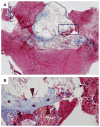Recent insights into cerebral cavernous malformations: animal models of CCM and the human phenotype
- PMID: 20096037
- PMCID: PMC2859824
- DOI: 10.1111/j.1742-4658.2009.07536.x
Recent insights into cerebral cavernous malformations: animal models of CCM and the human phenotype
Abstract
Cerebral cavernous malformations are common vascular lesions of the central nervous system that predispose to seizures, focal neurologic deficits and potentially fatal hemorrhagic stroke. Human genetic studies have identified three genes associated with the disease and biochemical studies of these proteins have identified interaction partners and possible signaling pathways. A variety of animal models of CCM have been described to help translate the cellular and biochemical insights into a better understanding of disease mechanism. In this minireview, we discuss the contributions of animal models to our growing understanding of the biology of cavernous malformations, including the elucidation of the cellular context of CCM protein actions and the in vivo confirmation of abnormal endothelial cell-cell interactions. Challenges and progress towards developing a faithful model of CCM biology are reviewed.
Figures



Similar articles
-
Recent insights into cerebral cavernous malformations: the molecular genetics of CCM.FEBS J. 2010 Mar;277(5):1070-5. doi: 10.1111/j.1742-4658.2009.07535.x. Epub 2010 Jan 22. FEBS J. 2010. PMID: 20096038 Review.
-
Recent insights into cerebral cavernous malformations: a complex jigsaw puzzle under construction.FEBS J. 2010 Mar;277(5):1084-96. doi: 10.1111/j.1742-4658.2009.07537.x. Epub 2010 Jan 22. FEBS J. 2010. PMID: 20096036 Free PMC article. Review.
-
The pathogenetic features of cerebral cavernous malformations: a comprehensive review with therapeutic implications.Neurosurg Focus. 2010 Sep;29(3):E2. doi: 10.3171/2010.6.FOCUS10135. Neurosurg Focus. 2010. PMID: 20809760 Review.
-
Defective autophagy is a key feature of cerebral cavernous malformations.EMBO Mol Med. 2015 Nov;7(11):1403-17. doi: 10.15252/emmm.201505316. EMBO Mol Med. 2015. PMID: 26417067 Free PMC article.
-
A novel mouse model of cerebral cavernous malformations based on the two-hit mutation hypothesis recapitulates the human disease.Hum Mol Genet. 2011 Jan 15;20(2):211-22. doi: 10.1093/hmg/ddq433. Epub 2010 Oct 11. Hum Mol Genet. 2011. PMID: 20940147 Free PMC article.
Cited by
-
Mutations of RNF213 are responsible for sporadic cerebral cavernous malformation and lead to a mulberry-like cluster in zebrafish.J Cereb Blood Flow Metab. 2021 Jun;41(6):1251-1263. doi: 10.1177/0271678X20914996. Epub 2020 Apr 4. J Cereb Blood Flow Metab. 2021. PMID: 32248732 Free PMC article.
-
Phenotypic characterization of murine models of cerebral cavernous malformations.Lab Invest. 2019 Mar;99(3):319-330. doi: 10.1038/s41374-018-0030-y. Epub 2018 Jun 26. Lab Invest. 2019. PMID: 29946133 Free PMC article.
-
Intravital Imaging of Disease Mechanisms in a Mouse Model of CCM Skin Lesions-Brief Report.Arterioscler Thromb Vasc Biol. 2025 Jan;45(1):113-118. doi: 10.1161/ATVBAHA.124.321056. Epub 2024 Nov 21. Arterioscler Thromb Vasc Biol. 2025. PMID: 39569520
-
Compound Heterozygous Loss-of-Function Variants in CCM2L in a Fetus With Tetralogy of Fallot.Mol Genet Genomic Med. 2025 Jun;13(6):e70117. doi: 10.1002/mgg3.70117. Mol Genet Genomic Med. 2025. PMID: 40521769 Free PMC article.
-
Contribution of protein-protein interactions to the endothelial-barrier-stabilizing function of KRIT1.J Cell Sci. 2022 Jan 15;135(2):jcs258816. doi: 10.1242/jcs.258816. Epub 2022 Jan 25. J Cell Sci. 2022. PMID: 34918736 Free PMC article.
References
-
- Otten P, Pizzolato GP, Rilliet B, Berney J. A propos de 131 cas d’angiomes caverneux (cavernomes) du S.N.C. repérés par l’analyse rétrospective de 24 535 autopsies. Neuro-Chirurgie. 1989;35:82–83. 128–131. - PubMed
-
- Robinson JR, Awad IA, Little JR. Natural history of the cavernous angioma. J neurosurg. 1991;75:709–714. - PubMed
-
- Toldo I, Drigo P, Mammi I, Marini V, Carollo C. Vertebral and spinal cavernous angiomas associated with familial cerebral cavernous malformation. Surg neurol. 2009;71:167–171. - PubMed
-
- Laberge-le Couteulx S, Jung HH, Labauge P, Houtteville JP, Lescoat C, Cecillon M, Marechal E, Joutel A, Bach JF, Tournier-Lasserve E. Truncating mutations in CCM1, encoding KRIT1, cause hereditary cavernous angiomas. Nature genetics. 1999;23:189–193. - PubMed
-
- Sahoo T, Johnson EW, Thomas JW, Kuehl PM, Jones TL, Dokken CG, Touchman JW, Gallione CJ, Lee-Lin SQ, Kosofsky B, et al. Mutations in the gene encoding KRIT1, a Krev-1/rap1a binding protein, cause cerebral cavernous malformations (CCM1) Hum mol genet. 1999;8:2325–2333. - PubMed
Publication types
MeSH terms
Substances
Grants and funding
LinkOut - more resources
Full Text Sources
Other Literature Sources

